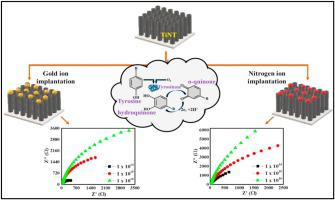Colloids and Surfaces B: Biointerfaces ( IF 5.4 ) Pub Date : 2020-07-02 , DOI: 10.1016/j.colsurfb.2020.111239 Jyoti Bala 1 , Souradeep Roy 2 , Alishba T John 2 , Shikha Wadhwa 2 , Ashish Mathur 2 , Devraj Singh 3 , Devarani Devi 4 , Ambuj Tripathi 4

|
One of the common complications diagnosed in Diabetes Mellitus (DM) patients is Diabetic Foot Ulcers (DFUs). It is a condition wherein the deep tissues located in the lower limb undergo inflammation and infection due to neurological abnormalities (neuropathy) and various degrees of vascular diseases (angiopathy). The concentration of l-tyrosine (Tyr) rises abruptly in DFUs, and therefore may be used as an indicator for early monitoring of the patient’s condition during the onset of diabetic foot disease. Herein, we report the electrochemical enzymatic detection of Tyr using low energy ion beam modified titania nanotube (TiNT) thin films with nitrogen (N+) and gold (Au−) ions. Electrochemical Impedance Spectroscopy (EIS) analysis was performed to investigate the levels of Tyr using ion beam modified TiNT thin film electrodes. The modified electrodes exhibited excellent sensor performances with Au-TiNT and N-TiNT within the Tyr concentration range of 100 fM −500 μM with limit of detection (LoD)1.76 nM and 1.25 nM respectively and response time ∼ 1 min. The results indicate that low energy ion beam modified TiNT/enzyme bio-electrodes can potentially be employed as a highly sensitive and portable sensor for real-time detection of l-tyrosine in wound fluids for the development of a smart bandage.
中文翻译:

离子束修饰的 TiO2 纳米管生物界面用于 L-酪氨酸的电化学检测,用于智能绷带应用。
在糖尿病 (DM) 患者中诊断出的常见并发症之一是糖尿病足溃疡 (DFU)。它是位于下肢的深部组织由于神经异常(神经病)和不同程度的血管疾病(血管病)而发生炎症和感染的病症。DFU中l-酪氨酸 (Tyr)的浓度突然升高,因此可用作早期监测糖尿病足病发作期间患者状况的指标。在此,我们报告了使用低能离子束改性二氧化钛纳米管 (TiNT) 薄膜与氮 (N + ) 和金 (Au -) 离子。使用离子束修饰的 TiNT 薄膜电极进行电化学阻抗谱 (EIS) 分析以研究 Tyr 的水平。在 100 fM -500 μM 的 Tyr 浓度范围内,改性电极与 Au-TiNT 和 N-TiNT 表现出优异的传感器性能,检测限 (LoD) 分别为 1.76 nM 和 1.25 nM,响应时间约为 1 分钟。结果表明,低能量离子束修饰的 TiNT/酶生物电极有可能用作高灵敏度和便携式传感器,用于实时检测伤口液中的l-酪氨酸,以开发智能绷带。











































 京公网安备 11010802027423号
京公网安备 11010802027423号